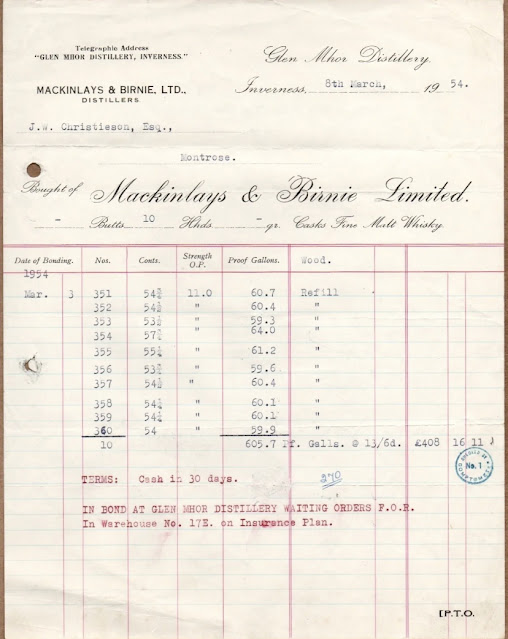Glen Mhor Cask Sale 8th March 1954
Recently, I was made aware of an interesting item that had come up for auction on eBay involving Glen Mhor. This is the first bill of sale I've seen, but I suspect it won't be the last, as filling such orders was the main order of business for the distillery, for several decades.
Sadly, I wasn't able to add it to my own personal physical collection, as I was outbid during the last minute. That's the way it goes, especially when a lot ends during the time when you're putting your son to bed. However, having grabbed images of the lot itself, I'm able to do the next best thing and document its existence for the project here. I hope the buyer enjoys the item.
A wee reminder that I'm always on the lookout for Glen Mhor related items and happy to pay a decent price - all you need to do it get in touch.
The bill itself is for 10 bourbon hogsheads which are all filled at the same strength and refill, although the number of refills is not specified. It also confirms by March of 1954 they were into the 300's in terms of cask fulfilment, which might be a useful marker if reliable. These were left in bond at one of the Glen Mhor warehouses with the total cost being £408.16.11, or in today's money, roughly adjusting for inflation this would be around £14,292, which spread over 10 casks isn't too bad. I wonder how much a cask of Glen Mhor would fetch at auction today, never mind 10?
On the reverse, we have the terms and conditions were are more simplified than today's process of owning a cask. However, given their reliance on filling casks, Mackinlay & Birnie would be well versed in such matters.
The conditions make reference to Distillery Railway Station, which will be the part of the network laid down by the US Military during World War 1. Interestingly, Glen Mhor did not offer a service of empty casks, and any would-be owners, would have to provide their own casks of sufficient quality - or be charged for repairs. There does seem to be a war risks clause in the T&Cs which could be a remnant of past conflicts - as far as I'm aware, no distillery in Inverness was bombed, but given the fate of Banff, it made sense to cover that aspect. The risk of fire also is covered with a maximum value depending on the type of cask you owned. Also, the option for Mackinlay & Birnie to order the removal of casks (after 3 years) if they required room in their warehouses.
Initial enquiries with regards to the purchaser of these casks in Montrose has come up blank, but I expect more updates on this in time. Oh, and already we can link this purchase to the following bottler, my thanks to East City Whisky Club for the assistance.
A fascinating slice of Glen Mhor and whisky history; just showing what is out there.
This will be added to our documentation section and hopefully as more cask filling details come to light, we'll be able to learn more about this vital part of the trade.



Comments
Post a Comment